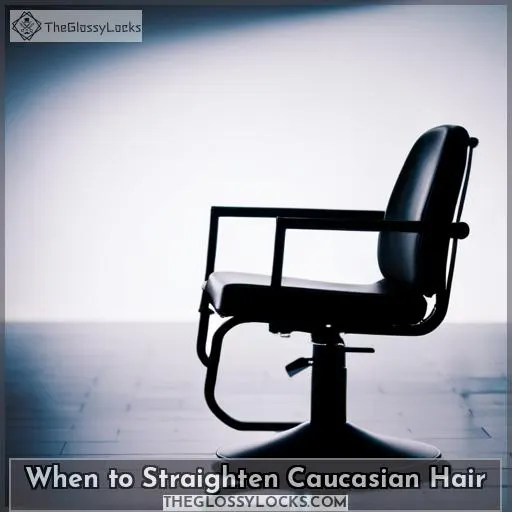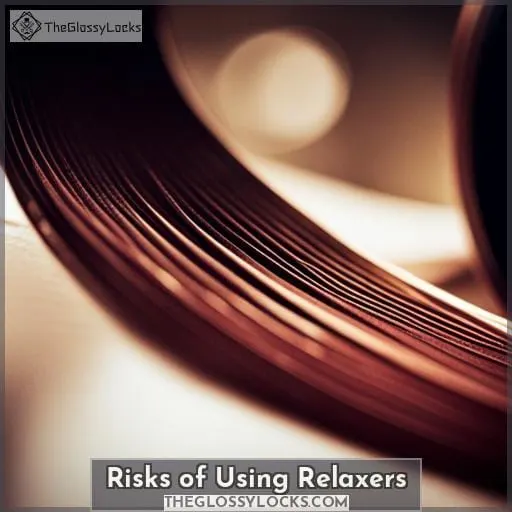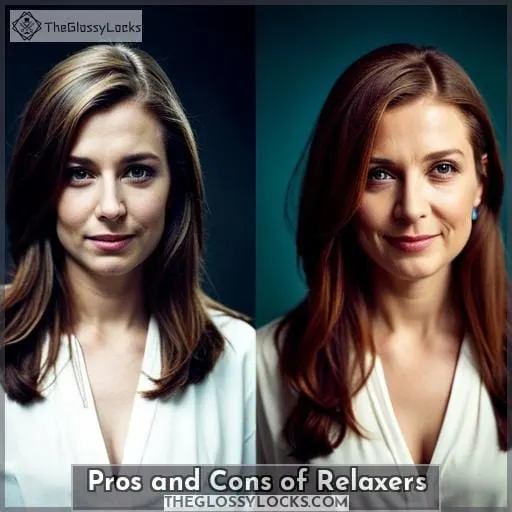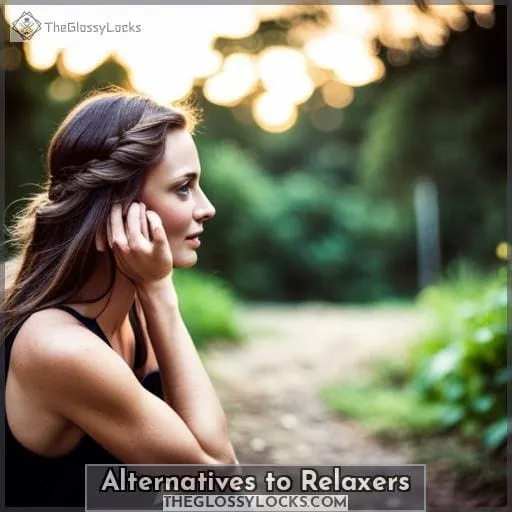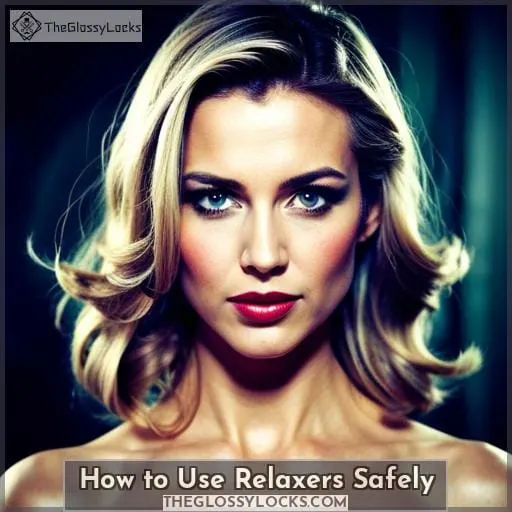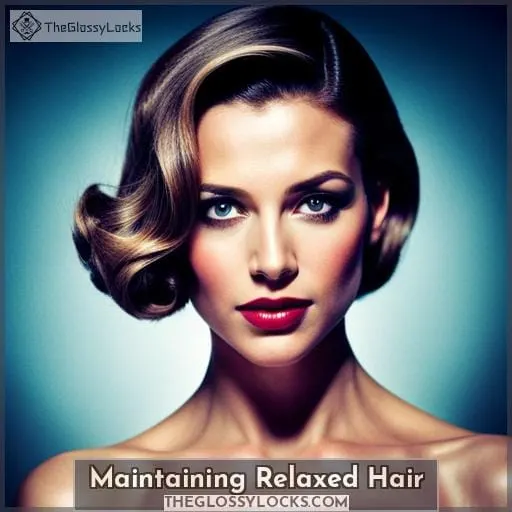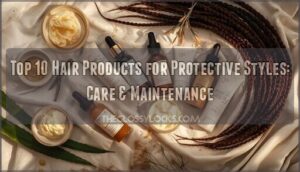This site is supported by our readers. We may earn a commission, at no cost to you, if you purchase through links.
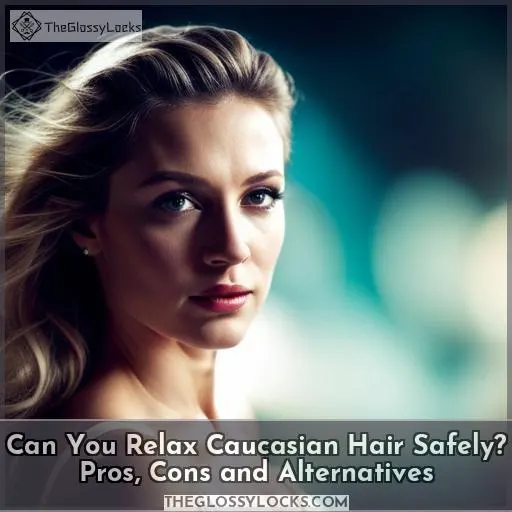 You’re tired of hiding your naturally wavy hair under blowouts and flat irons, aren’t you? We get it – dealing with unruly, coarse Caucasian hair can feel like a full-time job.
You’re tired of hiding your naturally wavy hair under blowouts and flat irons, aren’t you? We get it – dealing with unruly, coarse Caucasian hair can feel like a full-time job.
But before you reach for that relaxer, let’s talk about the risks.
Sure, permanently straight hair sounds nice, but relaxers can damage your locks, health, and self-esteem.
We’ll lay out the pros, cons, and safer styling options, so you can decide if it’s truly worth using lye.
Your hair is part of what makes you beautifully you, so treat it with care.
We’ll help you do right by your strands so you can rock your texture with confidence.
Table Of Contents
Key Takeaways
- Relaxers offer pros and cons, including frizz control and versatility, but also come with risks like chemical damage and hair loss.
- To minimize relaxer-induced scalp damage, preventive measures such as using petroleum jelly, avoiding scratching, and seeking professional help are essential.
- Healthy hair is a reflection of overall health, so maintaining a balanced lifestyle is crucial for the care of relaxed hair.
- Consider alternatives to relaxers such as flat irons, blow-drying with a diffuser, and using natural hair masks, while taking care to protect and nourish your hair.
When to Straighten Caucasian Hair
Discovering your natural waves isn’t always easy, so give your locks some TLC when opting to straighten. Many assume relaxers are just for curly-haired gals, but us straight-haired folks deal with frizz too.
Before reaching for chemicals, find products that work with your hair’s natural texture. Use a leave-in cream to tame frizz or try air drying for smooth hair. If your hair’s extra thick, a serum or oil will keep it sleek.
Don’t forget heat protectant before flat ironing or blow drying to minimize damage. When choosing a relaxer, opt for a mild formula with conditioner and do a strand test first to avoid overprocessing.
With the right tools and techniques, you can rock straight locks without compromising your hair health.
Risks of Using Relaxers
Relaxers carry risks that should give you pause before using them. Severe scalp damage, life-threatening health conditions, and permanent hair loss have all been connected to relaxers, especially the lye-based formulas.
Scalp Damage
You would risk scalp damage if using relaxers too often or improperly. Statistics show that over 20% of women have experienced burns or irritation from hair straightening chemicals.
- Use petroleum jelly as a barrier.
- Do not scratch or rub the scalp.
- Rinse thoroughly after application.
- Seek professional assistance.
- Follow all instructions carefully.
Sticking to a proper haircare regimen and visiting a professional hairstylist can help minimize damage from the chemical process of relaxers.
Life-Threatening Ailments
While uncommon, significant cases link no-lye relaxers to reproductive effects and cancer. When used incorrectly, no-lye relaxers pose health threats from chemical exposure. Even when following instructions, taking in harmful substances over time damages hair and risks life-threatening illnesses.
When treating your locks, prioritize safety. Research product components and application techniques. Consult specialists. Although outcomes astonish, no beauty routine outweighs your wellness.
Hair Loss
But if misused, relaxers can cause serious hair loss. I know some might say it’s no big deal since hair grows back, but for those struggling with thinning hair, losing more of those precious strands is heartbreaking.
Over-processing and leaving relaxers on too long damages hair follicles, causing hairs to fall out prematurely. Getting regular trims, using gentle shampoos, limiting heat styling, and taking hair supplements can help prevent excessive shedding.
For those with hair loss, wigs and extensions are viable options while waiting for regrowth. There’s no need to live with sparse, thin locks. Seek professional help for thinning hair after relaxer use.
Pros and Cons of Relaxers
Many different hair types can benefit from relaxer treatments, though they come with advantages and disadvantages to consider. Weighing the pros and cons will help you determine if relaxing is suitable for your hair goals and manageability.
Pros
Say goodbye to frustrating frizz and unmanageable curls once and for all. With relaxers designed for your hair type, you’ll enjoy a sleek, smooth, straight look that stays for weeks. Daily maintenance is easy with the right shampoo, conditioner, and leave-in products to lock in moisture, protect from damage, and prep for quick styling.
Getting your ideal style is effortless with options like soft waves, straight locks, or fun updos. With some planning, you can maintain your hair’s health while reaping the rewards of a polished, professional style.
Relaxers open up new styling possibilities so you can express your personal flair. Consult trusted pros about relaxer options and recommended products for your hair goals. Discover the freedom to wear carefree hairstyles that save you time, boost confidence, and let your inner beauty shine.
Cons
Didn’t the possible hair loss, damage, and chemical burns make you wonder if it’s really worth it? Using hair relaxers can seem tempting, but consider the potential downsides:
- Chemical damage and breakage
- Scalp irritation or burns
- Increased risk of hair loss
- The need for touch-ups and salon visits
Rather than risk the dangers of relaxers, try some natural alternatives for taming frizz and managing thick, wavy locks.
Alternatives to Relaxers
While relaxers can yield straight hair, alternatives like flat irons, blow drying, and hair masks might suit some Caucasians’ hair care needs. Consider the pros, cons, and your hair type as you explore gentler options for achieving your desired style.
Relaxers, which chemically straighten hair, can damage strands over time. Other methods like blowouts or keratin treatments temporarily smooth hair. Permanent options like Japanese straightening also exist. Discuss your goals with a stylist to find the healthiest route for your hair’s texture.
With an open mind, you can land on a routine that makes styling easier while keeping your locks strong.
Flat Irons
You can straighten with a flat iron daily to achieve sleekness without relaxer risks. Yet be mindful of heat damage. Prepare with a good heat protectant, then section out dry tresses for even heat distribution.
Clamp hair near roots, glide down slowly. Repeat on small sections until straight, finishing styling with a rounded brush. Intersperse flat ironing with nourishing deep conditioning to counteract drying effects.
Consider a gentler blowout or keratin treatment for a less damaging routine. Healthy hair care is key.
Blow Drying
After flat irons, many try blow drying their frizzled locks. Blow drying can help tame frizz and enhance your hair’s natural texture with these tips:
- Use a diffuser attachment for curly hair. Direct air flow downwards to boost volume.
- Apply a heat protectant beforehand. This helps minimize damage from the dryer’s heat.
- Lower the temperature setting. Too much heat leads to frizz and breakage over time.
- Try different techniques like flipping your head upside down or sectioning hair. Finding what works for your locks prevents frizz.
With some trial and error, blow drying can help you style your hair just the way you like it.
Hair Masks
Cause your locks could use some TLC, give a nourishing hair mask a whirl before you reach for the flat iron. Mix up DIY hair masks with coconut oil, olive oil, avocados, or honey for deep conditioning.
Load your hair with moisture, antioxidants, proteins, and vitamins through ingredients like argan oil, mayonnaise, eggs, bananas. When used weekly, masks boost shine, smoothness, strength, and manageability without the damage of dyeing or heat styling.
How to Use Relaxers Safely
To use relaxers safely on Caucasian hair, it’s essential to follow specific dos and don’ts. These guidelines will assist you in achieving the desired results while minimizing potential risks and ensuring the health of your hair and scalp.
Dos
To ensure safe usage, always follow these crucial dos:
Did you know that proper application can reduce the risk of scalp damage by 50%?
Start by consulting a professional for your Caucasian hair relaxer application. They’ll determine the right type and strength for your hair texture.
Prior to application, apply petroleum jelly to your hairline to prevent skin irritation.
Remember to avoid scratching, brushing, or combing your hair and scalp immediately before a relaxer.
Treat new growth separately to maintain a uniform look, and refrain from using relaxers on over-processed or bleached hair.
After the process, invest in diligent haircare maintenance and styling tips to ensure lasting results.
Engage with social media for support and inspiration, and share your own experiences to help others in their hair journey.
Don’ts
Avoid using strong chemical products on your hair, as this can lead to potential scalp damage and hair weakening.
When it comes to hair relaxer safety, there are several important don’ts to keep in mind:
Don’t Overlap Relaxer Application: Applying relaxer to previously treated hair can lead to over-processing, breakage, and severe damage. Always focus on the new growth to maintain healthy results.
Don’t Neglect Relaxer Aftercare: After using a relaxer, proper haircare is essential. Don’t skip conditioning treatments and moisturizing routines to keep your hair nourished and strong.
Don’t Ignore Alternatives: If you’re concerned about the safety of relaxers, consider exploring alternative straightening techniques like Japanese hair straightening or Brazilian Keratin treatments that might better suit your needs.
Prioritize your hair’s health and safety by avoiding these common mistakes in your hair relaxing journey.
Maintaining Relaxed Hair
To maintain your straightened and sleek look, regular conditioning and moisture treatments are essential.
Haircare routines play a crucial role in keeping your relaxed hair in tip-top condition. Invest in a quality sulfate-free shampoo and conditioner specifically designed for chemically treated hair. These products will help maintain your hair’s moisture balance and prevent excessive dryness.
Additionally, deep conditioning treatments should be a part of your routine to provide your hair with the nourishment it needs.
When it comes to styling, be gentle with your hair. Avoid excessive heat styling, which can lead to damage and breakage. Opt for heat protectant sprays when using hot tools, and choose lower heat settings whenever possible.
Silk or satin pillowcases can help reduce friction, minimizing the risk of hair breakage.
For frizz control, consider using anti-frizz serums or lightweight hair oils.
Product recommendations are crucial. Consult your stylist for the best products for your hair type and needs. They can suggest leave-in conditioners, serums, and styling products that will enhance the longevity of your relaxed hair.
In this way, you’ll not only maintain your fabulous straightened look but also keep your hair healthy and radiant.
Conclusion
To conclude, when it comes to relaxing Caucasian hair, the irony lies in the fact that even those with straighter hair may find the need for it. But, as with any hair treatment, there are essential considerations. You’ve learned about the risks, including potential scalp damage and life-threatening issues, as well as the pros and cons of relaxers.
If you’re seeking alternatives, flat irons, blow-drying, and hair masks can be your go-to options. Remember, safe use is key, so follow the dos and don’ts. And once you’ve achieved the sleek look, maintaining your relaxed hair is crucial.

